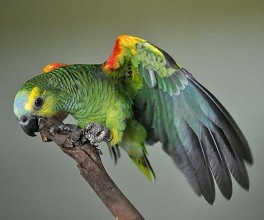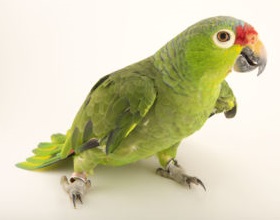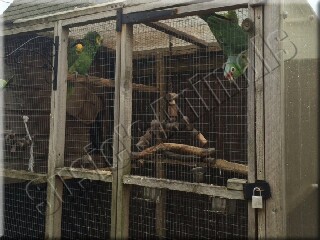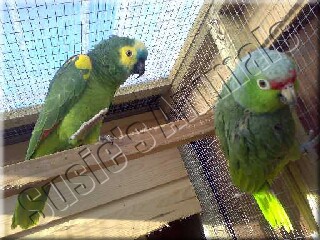Amazon Parrot is the common name for a parrot of the genus Amazona.
These are medium-sized parrots native to the New World ranging from South America to Mexico and the
Caribbean. It contains the largest diversity of parrot species, though in only 6 genera. The genus Amazona
(to which amazons belong) was established by René Lesson in 1830. It was a Latinized version of the name
Amazone given to them in the 18th century by the Comte de Buffon, who believed they were native to Amazonian jungles.
The Amazona genus bears the name of the great river running
 |
| Blue Fronted Amazon |
through continent of South America, but has come to
include this large number of parrots that are found throughout the New World. Amazons are found in mountains, wooded
areas, tropical forests, and savannahs. Most amazon parrots are predominantly green, with accenting
colours that depend on the species and can be quite vivid. They feed primarily on seeds, nuts, and fruits, supplemented by leafy
matter. They live in colonies, but mate for life with just one other bird. Living with a mate is part of the social
pattern of the Amazon parrot. To live well, they need close companionship. With the discovery of the new world,
Amazon parrots of Central and South America were brought to Spain, and from there to rest of Europe. In 1492, on his
return voyage from the Americas to Spain, Christopher Columbus reportedly brought a pair of Caribbean Cuban Amazons to
his patron, Queen Isabella. But it was the European naturalists of the 19th century, explorers with great geographical
and zoological interests that expanded knowledge of Amazons and many other creatures. This was a romantic period
where exotic birds became highly favoured with British nobility and royalty. They found them enchanting, and their
ability to speak startling. In the 1800's many volumes were written about birds and parrots. Yet the Green parrots,
soon called Amazon Parrots, were often confused in early classifications. Amazons were less common and of higher
value due to the long and arduous ocean voyage to bring them from the Americas. Early aviculturists found it difficult
to identify them, there was such a variety of species and colour variations. Even today experienced ornithologists
are still scrutinizing and re-arranging their classification. By the later 1800's and early 20th century, ocean crossing
became less expensive and more common. All sorts of people, from sailors and innkeepers to common and educated folks,
were able to keep Amazons and other large parrots. Green Amazon Parrots as well as Grey parrots
 |
| Salvin's Amazon |
became the rage. These
birds were displayed in parlours and places of social gathering. Amazons Parrots became even more popular in the United
States than in Europe because they were more readily available here. This was due to their geographic origin and a shared
Mexican border, which provided an easy access route for importation. The first half of the 1900's saw interest in large
parrots fluctuate up and down with turns in national events. Parrot keeping was affected by the two world wars, as well
as several periods of bird disease outbreaks. After World War II, with inexpensive air transportation, importation rose.
Keeping large parrots again become highly favoured. Parrots of all types arrived in abundance into the United States,
spurring aviculture and captive breeding. Today bird importation is greatly restricted, but many parrot species (over
280) are successfully bred in captivity, and Amazon Parrots are readily available. Many amazon parrots have a remarkable
ability to mimic human speech and other sounds. Partly because of this, they are popular as pets or companion parrots,
and a small industry has developed in breeding parrots in captivity for this market. This popularity has led to many
parrots being taken from the wild to the extent that some species have become threatened. "The Convention on International
Trade in Endangered Species" of Wild Fauna and Flora treaty has made the capture of wild parrots for the pet
trade illegal in an attempt to help protect wild populations.









